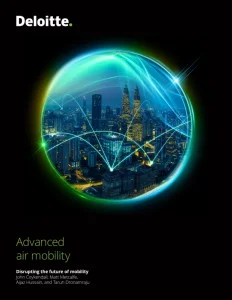- Directory
- Advanced Air Mobility White Papers
- Advanced Air Mobility (AAM)
- Advanced air mobility: Disrupting the future of mobility
Advanced air mobility: Disrupting the future of mobility
White Paper Details
Deloitte's white paper explores advanced air mobility as a transformative force in future transportation. The document examines how aerial vehicles will revolutionize urban mobility, featuring a futuristic visualization of connected air transport networks over cityscapes, representing the integration of flying vehicles into metropolitan transportation ecosystems.
This white paper on "Advanced air mobility: Disrupting the future of mobility" by Deloitte positions advanced air mobility (AAM) as a revolutionary paradigm shift in transportation infrastructure. The document, authored by John Coykendall, Matt Metcalfe, Aijaz Hussain, and Tarun Dronamraju, explores how emerging aerial vehicle technologies will fundamentally transform how people and goods move through urban environments.
The white paper likely addresses the convergence of several key technologies enabling AAM, including electric vertical takeoff and landing (eVTOL) aircraft, autonomous flight systems, and advanced air traffic management solutions. These innovations promise to alleviate ground congestion, reduce travel times, and create new mobility corridors above existing city infrastructure.
Deloitte's analysis presumably covers the ecosystem required to support AAM implementation, including regulatory frameworks, infrastructure development such as vertiports, and integration with existing transportation networks.
The document likely examines various use cases, from urban air taxis and emergency medical services to cargo delivery and regional connectivity.
The striking cover image, featuring a glowing sphere encompassing a nighttime cityscape with interconnected light trails, symbolizes the comprehensive nature of AAM's impact on urban environments. This visualization reinforces the white paper's central thesis that advanced air mobility represents not merely an incremental improvement but a fundamental disruption to traditional mobility concepts.
Key stakeholders addressed likely include city planners, transportation authorities, aerospace manufacturers, investors, and policymakers who must collaborate to realize AAM's potential. The white paper presumably outlines both opportunities and challenges, including technological hurdles, safety considerations, public acceptance, and the need for new regulatory frameworks to govern three-dimensional urban airspace.
